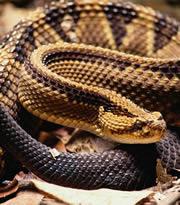 Snakes can lower their resting metabolic demands by up to 72%, while staying alert.Punchstock
Snakes can lower their resting metabolic demands by up to 72%, while staying alert.PunchstockSome snakes are known to be able to go without food for periods of nearly two years. Until recently, the mechanism behind this unique skill was unknown, but new research has revealed some previously-unknown serpentine tricks. These may form the key adaptation that has kept this highly specialized group alive since before the days of Tyrannosaurus rex, biologists say.
Biologists have long argued that there are two main tactics used by animals to weather a period of starvation. The core body temperature can be reduced, as is the case in penguins that go through torpor to reduce their calorie use during the winter. Hibernating animals such as hedgehogs utilize another method by stocking up on food and then reducing activity levels. Some species, including polar bears, do both.
Snakes, it would seem, have an altogether different strategy at their disposal — they can save on energy use without lowering their temperature and while staying fully alert. As a bonus, they can also go hungry for longer without starting to 'eat' their own body from the inside.
How low can you go?
Biologist Marshall McCue at the University of Arkansas, Fayetteville, kept ratsnakes, pythons, and rattlesnakes in cages where they could not alter their activity levels — they were forced to be inactive. They were also unable to reduce body temperature, stuck with the laboratory temperature of a steady 27 ºC. The animals were then starved for a period of up to 168 days.
McCue measured the animals' oxygen consumption and found that they had somehow managed to reduce their resting metabolic demands by up to 72%. "We had no idea that these animals could reduce their metabolic rates lower than their standard resting rate," says McCue. "It would seem that their pilot light, which we already thought to be as low as possible, can actually go much lower."
How the snakes were lowering their metabolic rates, without lowering their temperature — and while staying alert enough to attempt to bite their captor — is a mystery. McCue thinks the snakes may be reducing the density of energy-generating cell machinery called mitochondria in highly active tissues such as those in the liver and heart.
In addition, the snakes had a cunning way to stretch out their resources while enduring starvation. All animals burn lipids — the compounds that make up fat — for energy when they run out of food. But lipids have some essential functions in the body, forming crucial parts of cells and organs needed for nutrient transfer, for example. So as starvation progresses and fat reserves run low, most animals turn to protein in the body and begin using that as an energy resource instead. This essentially means that they begin to digest themselves — a process that can only be tolerated for a short while before resulting in death.
"In most starving animals, allowing lipid levels to fall below 10% body mass is a death sentence," says McCue. But snakes were able to go down to 5% body fat before making a switch to protein consumption, he found, letting them hold on for longer without food. "Even then, consuming their own proteins had little effect on their health because they had slowed down their metabolism so drastically," he says.
Survival skills
"The ability to selectively utilize lipids at low levels, thereby conserving structural proteins, could be a key breakthrough in understanding starvation survival," says physiologist Anthony Steyermark of the University of St Thomas, Minnesota.
ADVERTISEMENT
But perhaps more important is the amount of metabolic depression seen in these animals below the standard resting level, he adds. "The whole idea of a standard metabolic rate may need rethinking."
The research, which is published in the journal Zoology1 next month, may have significant paleontological implications. Enduring periods of starvation may be key to the survival of a species during lean times. If other animals with early evolutionary origins — such as turtles, sharks, and amphibians — are found to also be able to lower their metabolic rate without affecting their alertness, this could better explain why these animals survived through times of mass extinction.
Visit our strikebackatstarvati.html">newsblog to read and post comments about this story.
